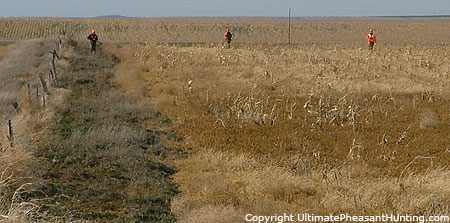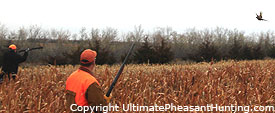Hunting Wild Pheasants
By Ryan Trask
Ultimate Pheasant Hunting
Hunting seasoned old wild pheasants is plain common sense. Hunting effectively is the key to maximize your rooster count.

Hunting smart birds can be fun and frustrating at the same time. Smart birds will run until they have no other option but to fly.
In this article, I will cover some hunting tips that can help you bag more roosters and have a more enjoyable group hunt.
Organization
Get organized before you hit the field or even get close to the field so you don't spook the roosters. Everyone is always anxious to get into the field, but if you don't figure it out, you will spook the roosters and screw up the entire field. Roosters get up in packs and if you spook one, the rest will follow.
I have even been out at a hunting operation where they had a dry erase board and drew up a plan and how to hunt the plot effectively or have even witnessed a hunting plan in dirt. Hey, whatever works.
I have heard several people comment on the blocking style of hunting. Comments like: "I don't hunt that way"; "That's not hunting"; "Your corralling birds up"; "That's pheasant shooting and not hunting"; "That's South Dakota style"; "That's dangerous hunting".
My comment to that: The definition of hunting is; "The practice of pursuing animals for food, recreation, trade or for their products."
Say what you want. If you want to hunt smart, seasoned, wild late season birds, then you will need to adapt to a variation of this style of hunting or you don't have a chance of even shooting your gun that day.
Roles
Photo Example: 2 flankers off to the left, 6 walkers, 3 dogs, 2 flankers off to the right and 3 blockers equidistant out of sight.

Note: Everyone has had a 15 minute safety talk before the hunt. Safe shots only and wear eye protection for splashing pellets.
Walkers & Dogs
Most everyone likes to walk because of the action or of course to stay warm on a cold day. Usually the dog owners get to walk all the time if there are few dogs in the group. The key of the walkers and dogs is to work the piece of cover and push the birds to keep the birds on the run.
As the walkers are moving the birds forward, the flankers keep the birds in the wedge, and really the only place for them to go is to fly in the gaps so hunters make tough shots.
The only other logical place for birds to escape is the dead zone between the blockers and the flankers. It's unavoidable, you are going lose birds here, the key is to keep the percentage down.
Flankers or Side Posters
 Huge spurs on this old bird. He ran half of the field in very weak cover (view very top photo in article). |
It helps if the flankers are quiet and say a little bit wide instead of walking right next to the cover so they don't spook the roosters.
The real key to flanking is to walk along with the wedge at a even pace and keep the birds running to the end of the cover. When the flankers come to the end of the field it is their job to funnel around to the blocking position, take the corners or stay at the sides of the cover.
At the end of the cover, be patient and hold up and let the dogs work. Hunters get surprised when they see several birds piling out at the end of the cover, even when no one is doing anything. Birds sit tight, get nervous, and won't move unless they sense danger.
Blockers/Posting
 A blocker goes after a high flying ringneck. |
Blocking can be the black sheep role of the group or the "demotion" because it can be cold and boring. I don't see it that way.
Blocking to me is "the end of the line" and if you aren't a good shot, you are going to get owned by the birds. I love to block. It can make you a hero or a laughing stock of the group over beers and steak later that evening.
The moment you get at the end of the field, the roosters are sitting there already. Even though you don't see or hear them, they are there, and very nervous. Have your shells in your gun and ready to shoot. I have bagged 2 roosters in a row at the end of a field many times and the key is being ready because they will blast out of there at one time.
Last year in 2006, late season in Presho, South Dakota I got to the end of the field to block. As I got out of the ATV, and got in position, 3 roosters flew perfectly away from me. It was a dream shot as all 3 roosters were in a perfect line and right next to each other. 1 shot, 1 down. 2 shots, 2 down. 3 sh... 3 sh... the Bennelli jammed. It was cold, and I was lazy and didn't clean or oil my gun before the hunt. Lesson learned.
Other Hunting Tips
 Spike kicks up a rooster pheasant! |
Dogs
Walk the dogs into the wind, so the birds can't hear the dogs or hunters coming. It also gives the dogs more scent. Flushing dogs help in large plots.
Fill the gaps
Keep the group gaps equidistant and within shooting distance of each other. This will ensure good quality shots and makeable shots if a bird gets up in between 2 hunters.
Bird Flight Pattern
Birds will most likley (not always) bust out of the cover and shoot straight up if they are surrounded. The will then adjust their flight pattern and fly with the wind for speed purposes. If you are blocking, the might fly right by you at a blistering 30 mph, so be sure to lead your shot. I have had some tough overhead and side to side shots blocking.
 Pheasants start to pile out of the dead zone. |
Get after the birds
When you drop a rooster, put a mark on it with your eye and get after it. A lot of people fumble with a dog before their own eye. Keep your eye on it, then bring call the dog over.
After you have the mark and you can't find the downed bird, grab your blaze orange hat and put it on a cattail in the area to mark your spot.
Hustle into the field, be quiet, and get in place
Everyone is always anxious to get into the field. Have your plan set before you get out there. If you don't, you will spook the roosters and screw up the entire hunt. Roosters get up in packs and if you spook one, the rest will follow.
Stop Often
Stopping helps make birds nervous. Often if you have few dogs or if a dog missed a bird, pausing can make a bird want to get up because they know that there was movement, and being motionless and quiet make the bird think you are on to them, so they will fly rather than run.
 We downed all 11 of these roosters at the end of the field which was about 1/2 mile. The roosters ran the entire field. |
Walk to the end of the field
Walking all the way to the end of the field, while letting the dogs work the end of the plot you are walking is a must. Too often hunters work a piece of cover 3 or 4 football fields long only to give up at the very end of the plot when there are birds sitting right in front of their faces.
Zig Zag
If you have very few dogs in your group, zig zagging food plots helps the birds to keep running to the end of the plot.
Gun Selection
Over unders are nice, but functionally, only 2 shots hurts you and can hurt your group. We hunted a plot of grass that was about 18-24" high, about 50 yards. No birds got up the entire time until the blockers dropped their guns and the only 2 guns left were my Bennelli and a friend of mine (Joe) who brought his over-under.
 Two shots with the over-under and no rooster for Joe. |
Unfortuantely only 1 rooster flew my way, and it was a dangerous shot above the guides head so I didn't take it.
As dumb luck would have it, the roosters were piling out of Joe's side, 3 roosters popped up, Joe blasted 2 times and dropped 1 bird. The blockers couldn't help the situation since they were on the other side of the field and I was still in a danger zone and had no shot. As Joe was reloading his over-under, roosters and hens were just piling out one after another. Joe finally bagged 1 more rooster, as we all laughing hysterically about Joe fumbling while trying to load his gun.
Safety
Safety can be overlooked aspect of a group hunt. Glasses are a requirement at some operations and some they aren't. I have been shot twice and splashed dozens of times. The 2 hard shots were not from other group members, they were from my own friends! Pellet splashing is simply physics at work. Hunters shoot lead and steel shot in the air and eventually it fall. Yes, sometimes you are in line and it will hit you. It really isn't a big deal if they are way down the field.
I was hunting with a group in 2004 when a gentlemen got shot in the throat with lead shot. We have all heard of stories like this, and it is completely avoidable if you have a safety talk before the hunt and every hunter recognizes to shoot above the horizon, let the roosters get outside of the hunting group, then shoot at it.
I would let a rooster fly away versus taking a questionable shot. A single rooster is just not worth it.
Conclusions
If you haven't hunted this style, it may sound strange. If your going to hunt the Dakota's or in the upper midwest the birds are very wild and seasonsed so be ready to adapt your hunting style.
Hunting in this style may not be your preference, but use one or a few of these tips if you are struggling trying to get a shot for the day. Good luck!
